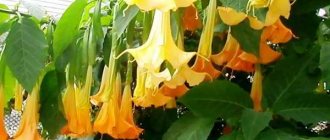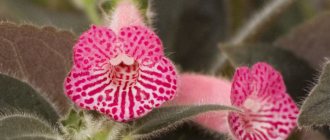Photo of the cactus Gymnocalycium is a charming cactus with a spherical stem and bright, beautiful flowers . Many gardeners prefer cacti due to the delicate charm of their needles and flowers. To make the plant comfortable, you need to know as much as possible about it and the rules of care in order to provide it with everything it needs.
- Origin: Gymnocalycium cactus is native to South America. It grows wild in Bolivia, Argentina and Brazil.
- Size: The name Gymnocalycium covers several different species, ranging in size from 3 cm to 30 cm.
- Flowering: Beautiful flowers appear regularly on flower tubes that have no hairs or spines on the surface. Almost all cactus species begin to bloom when they are 2 or 3 years old, starting in the spring and ending in the fall.
| The cactus has a slow growth rate. |
| Flowering begins in spring and ends in autumn. |
| The plant is easy to grow. |
| Perennial. |
What does a Gymnocalycium cactus look like?
The plant belongs to the Cactus family. From Latin the name Gymnocalicium is translated as “bare calyx”. The flowers are not covered with hairs, but are covered with smooth scales. The height of the trunk can vary from 1.5 to 7 cm. The diameter can be 2.5-15 cm. The shape of the above-ground part is round or flat. Flowers can have different shades.
Appearance
There are more than 150 species of Gymnocalycium that share the same botanical description. This is a perennial plant with dense roots that go deep into the ground. The aerial part is dark green in color, and the skin itself is smooth to the touch.
Additional Information! Varieties have been selectively bred whose shoots can be yellow, red or orange.
The most common types of Gymnocalycium:
- Reductum;
- Friedrich or Japanese;
- Baldianum or Balda;
- Mikhanovich;
- Horst.
Appearance of one of the varieties
There is also a separate group of the species, which is formed from several plants similar in shape and size.
Botanical description of Gymnocalycium baldianum (Baldianum)
Cactus hymnocalicium is a succulent with a flattened, spherical stem. It comes in different colors: brown-green, brownish, gray or green with silver.
The thickness of the stem is 4-15 cm, which is two times less than its height. It has 10-32 vertical ribs, which are covered with areoles with tufts of long spines.
At the top of the stem part, flowers of Gymnocalycium Balda (May-November) are formed in the form of a bell. The diameter of the inflorescences is 2-7 cm. They have several rows of lanceolate-like petals, without spines and with closed cups. Coloring may be different:
- red;
- raspberry;
- yellow;
- creamy.
The fruits of hymnocalicium are similar in appearance to eggs and are covered with scales on top.
Shoots have a short, cylindrical appearance . The ribs contain up to 20 stripes with a twisted spiral. They often have tubers located below the surface of the areole. The spines are 1.25-3.8 cm long. In some cases, the ends may bend towards the stem and usually they stretch along the sides or bottom.
As soon as the flower fades, an egg-shaped fruit appears on it. When ripe, the color of the fruit is green, red or purple.
Common varieties
How to plant a cactus: examples at home
This type of cactus is widespread in floriculture. Therefore, many varieties have been selected for decorative cultivation, among which are the most popular:
- Gymnocalycium Reductum (humpbacked) is the largest representative of the species. As it grows, the shape and color of the stem changes. The plant grows from a ball into an oval, which is divided by furrows. Reductum can grow up to half a meter. The spines are arranged radially. At the top of each segment there is a bunch with sharp long spines.
- Gymnocalycium Friedrich (Albiflorum). The succulent was obtained thanks to the efforts of Japanese breeders and therefore has a second name: Japanese gymnocalycium. After the chlorophyll was removed, the plant stem began to change color - purple, burgundy, red, yellow. The appearance attracts with its originality. But the hybrid cannot grow on its own; it must be grafted onto another cactus.
- Gymnocalycium baldianum - in Russia it is most often called Gymnocalycium Balda. It has the shape of a flattened ball of blue-green color. The height of the trunk reaches 10 cm and the width is 9 cm. Gymnocalycium Baldianum is covered with grooves, which turn into “tubercles” as they grow. At the top of each segment there are needles. Depending on the prefix, the color of the buds is determined - Kla, Yellow.
- Gymnocalycium Horst reaches a height of 20 cm. The stem has the shape of a flattened ball of dark green color. At the moment of flowering, you can see a bud of pink, lilac or cream color.
- Gymnocalycium mihanovichii has a 5 cm tall stem with comb-like projections. Along the crests there are waves that visually change the shape of the above-ground part. At the top of the ridges there are light spines, located only radially. The flower is pink-green, sometimes with white-green buds.
Friedrich's appearance
- Aqua Dulce is a miniature version of Gymnocalycium, which is distinguished by a low, powerful stem. Rare spines are found on the surface of the aboveground part.
- Gymnocalycium denudatum is a miniature species. The stem height does not exceed 30 mm in height, and the diameter is 80 mm. The shape of the aerial part is a ball, which is slightly flattened on top. At the time of flowering, it produces several small white buds.
- Damsi is classified as a succulent due to its small size (height 20 mm, diameter 50 mm). It has a round trunk of light green color with radially arranged needles along.
- Gymnocalycium ragonesii is a small cactus with a brown-green trunk. On the surface of the above-ground part, Ragonese has not very clear grooves, which are radially covered with spines.
- Gymnocalycium quehlianum (Quelya) is a succulent no more than 10 cm high. The color of the above-ground part is bluish-green. When flowering, the bud is colored red with a more expressive edging of the same color.
- Gymnocalycium spegazzinii has a barrel-shaped aerial part that is gray-green in color. The trunk is divided into ribs with areoles. They have curved spines 5-7 mm long.
Note! The “montain” label identifies the cactus as a frost-resistant plant. The maximum temperature drop can be +5 °C.
Appearance of Ruductum
Gymnocalycium mix cactus is a group of several small varieties. The diameter of the trunks does not exceed 50 mm. “Mix” is usually planted in one container, creating a combination of plants of different colors and different shapes.
Soil moisture
Watering Gymnocalycium correctly is not difficult - the principles apply to almost all plants living at home. It is irrigated as the soil in the pot dries. Watering should preferably be done with settled water heated at room temperature.
In summer, the plant is watered moderately but regularly, and from autumn to spring it is watered occasionally and little by little. It is important to take care of drainage, pour out excess liquid from the pan and allow the earthen clod to dry completely between waterings.
Features of home care
Astrophytum cactus: options for different types and examples of care at home
If we talk about this variety of cacti, including the Gymnocalycium mix variant, caring for them at home is not too difficult. Agricultural technology involves control over the main indicators - watering, temperature, humidity and light. If you properly care for a group of plants, then within the allotted time frame you can observe flowering, and the trunk itself will increase in size.
Temperature
The flower is not picky about temperature conditions, but its homeland is South America, which means it should still be warm. At different times of the year, succulents are grown at different temperatures:
- In summer, any temperature is suitable.
- In winter - +8-12 degrees Celsius, some require a temperature of +15-18 °C.
- The Mikhanovich cactus can grow at +5 °C in winter.
If the air temperature is too low, the plant will die.
Lighting
The plant needs good lighting. The stem should not be exposed to direct sunlight, otherwise burns in the form of brown spots will appear on the skin. The room should be well ventilated.
Cactus outdoors
Important! Flowerpots with plants should be placed on window sills on the south side to improve lighting at any time of the year.
If direct sunlight comes through the window, you need to artificially disperse them or remove the flowerpot for several hours in a more suitable place.
Watering
Watering is done approximately 2-3 times a month. You need to keep the soil dry. Only settled water at room temperature can be used in the irrigation process.
Implementation of watering
During the flowering period, the amount of watering may increase.
Attention! Once a month, you can add a drop of lemon juice to the watering liquid.
Spraying
Do not spray the stem of a cactus under any circumstances. Water entering the above-ground part can lead to rotting. The exceptions are those “baths” that involve treatment.
Humidity
There is no need to control air humidity in the summer, but it should not be 100%.
In winter, the figure should not exceed 70%. Otherwise, the plant will begin to rot. To maintain normal humidity in the room, you can use special devices.
Priming
Soil for cactus is a mixture of humus, turf soil, peat, and sand. All components are taken in equal quantities.
The right substrate
Attention! To improve the quality of the substrate, you can add a little charcoal.
Feeding
Fertilizing is done once a month during the growing season. In winter and autumn, the application of any fertilizers is prohibited. Mineral fertilizers that do not contain organic components are used as fertilizing. Supplements should contain some nitrogen.
Problems during cultivation
Problems when growing Gymnocalycium indoors arise from improper care of the plant. Most often, flower growers encounter the following troubles:
| Problem | Causes | Ways to correct the situation |
| Growth slowdown |
| Transplant the cactus into slightly alkaline soil and water it only with filtered water at room temperature |
| No flowering | Unsuitable living conditions in winter | In order for the gymnocalycium to bloom next year, it is necessary to move it to a cool and dry room in winter. |
| Dropping buds |
| The cactus must be protected from drafts and provided with additional lighting. |
| The appearance of spots at the base of the trunk | Overwatering | Water the cactus only when the top layer of soil dries out. |
If the base of the cactus has darkened, but remains dry and hard to the touch, then this phenomenon indicates the beginning of the suberization process. In this case, no special measures should be taken.
Features of care in winter, rest period
Gymnocalycium: mix and other popular plant species and cactus care at home
Gymnocalycium is a flower, caring for it at home during wintering requires the creation of special conditions. What you need to pay attention to:
- Watering is reduced to 1 time per month. Some species do not need to be watered at all.
- In the cold season, you need to reduce air humidity.
- It must be moved to a room with a temperature not lower than +15 °C.
- If the plant does not have enough light, diseases may appear, so sometimes the installation of artificial lighting is required.
There are no other features in winter care. After the end of the dormant period, you need to return the succulent to standard conditions.
Beneficial features
Gymnocalycium.
Photo Traditionally, they try to place this cactus closer to computers because they believe in its ability to absorb harmful radiation. This cactus has a beneficial effect on the atmosphere in the room, purifying the air and filling it with useful substances.
Sometimes cacti are even eaten, and various objects are also made from it, such as soap and deodorants.
When and how does it bloom
Gymnocalycium blooms at the age of 2-3 years. Some species may throw out a bud for the first time after 5 years. The plant can bloom annually, but some varieties only 2-3 times in their life.
Blooming succulent
Flowering begins in early to mid-April and this process continues until autumn.
The bud appears in a part of the trunk shaded from the sun. The flower blooms 10-14 days after appearance. The lifespan of a bud is 10 days.
For reference! The size, number and color of the buds depend on the specific variety of cactus.
If flowering occurs in autumn, the buds may not bloom. Such a nuisance can arise due to too good lighting.
Do I need to fertilize?
If desired, the soil can be fed, not forgetting that:
- We fertilize only in the spring-summer season.
- No more than once every two weeks.
- We use special mixtures and formulations selected for cactus species.
However, the cactus has no special requirements for feeding: this plant, like all tropical varieties, is capable of existing in completely spartan conditions.
How does the Gymnocalycium cactus reproduce?
You can propagate a cactus at home using lateral branches or seeds. Each option differs in the principle of care and the procedure itself. The simplest propagation option is considered to be transplanting a lateral or basal shoot. Germinating seeds is a more labor-intensive process that requires certain conditions to be met.
Germination of seeds
Reproduction by seed germination is considered the most difficult, but cacti grown in this way are resistant to any negative factors. You need to prepare a box 2-5 cm deep, pour a substrate of coarse sand and peat into the container.
Attention! The substrate is pre-heated in the oven for 1-2 hours.
When the ground has cooled, you need to place the seeds at a distance of 2-3 cm from each other and sprinkle them with a little soil mixture. The soil in the box should be constantly moist. You need to maintain the required level of moisture using a spray bottle. The air temperature should not fall below +20 °C.
After about 10 days, shoots appear. Such seedlings can be replanted only after 1-2 years.
Lateral layers
To propagate Gymnocalycium using lateral branches, you need to perform the following steps:
- Separate the shoot from the adult.
- Place it on a paper towel and dry in a dark place for 1 day.
- Prepare a pot with sandy soil.
- Press the cutting into the soil so that it does not fall.
Lateral shoots of a cactus
Within 14 days, roots appear on the shoot. It is better to carry out the procedure in the spring, when the plant enters the growing season.
Transfer
Sometimes basal shoots appear. They have an almost complete root system with the mother plant. Separation is carried out at the time of transplantation.
Transplanting a plant
You need to carefully separate the root systems and plant the shoot in a pot with soil. The substrate used is the same as for an adult plant.
Landing
To plant a cactus, you need to purchase a small pot made of plastic or ceramic. It must have holes for drainage. Large containers for gymnocalycium are not suitable, since the plant needs to feel the walls of the pot with its root system.
You can prepare the soil yourself by combining the following components:
- 3 parts each of leaf soil and sand;
- 2 parts each of turf soil and peat;
- 1 part crushed charcoal.
The soil for Gymnocalycium should be neutral or slightly alkaline, since the cactus does not tolerate acidic soil.
Ready-made soil for cacti can be purchased at a flower shop. Before planting, it is necessary to place a layer of drainage on the bottom of the pot and only then fill it with soil.
Pests and diseases
Due to improper maintenance of the flower, it may be affected by spider mites, rot or mealybugs. The causes of diseases and the fight against them are varied:
- Spider mites only appear on young plants. Dry and “rusty” spots appear on the skin. Appears due to low air humidity. To get rid of the pest, you need to treat the surface of the cactus with a solution of water and alcohol, and after finishing, be sure to ventilate the room.
- The mealybug parasitizes the root system and trunk. If there is no flowering, and the flower itself grows slowly, then the problem is the mealybug. To neutralize the pest, you need to dig up the plant and wash the roots and trunk under hot running water.
- Rot occurs as a result of too much watering. You need to dig up the cactus and remove rotten root shoots. Sprinkle the sections with activated carbon powder. And then plant it in new, disinfected soil.
Spider mite
If you follow the care recommendations, there will be no problems with pests. The only source of their appearance may be other infected plants.
Blooming specimen
You can decorate your home with unusual plants from the Cactus family, which belong to the genus Gymnocalycium. The cactus does not require special attention to itself and has a non-standard appearance. The bright colors of trunks and flowers inherent in certain types of this succulent make them “kings” in indoor floriculture. It is possible to attach some varieties to already adult individuals.
What to be afraid of
Cacti are unpretentious plants, but quite delicate, so they can be attacked by many pests:
Flat red tick. Their presence on the flower is indicated by dry, rusty vertical marks. It’s easy to get rid of them - wash the stem with hot water or ethanol.
Mealyworms. They suck all the juices out of the cactus, so special chemicals are required.
- Purposes of environmental certification
- Garden vacuum cleaners and leaf blowers: tips for choosing from “All prices”
Adenium - growing, care and secrets of growing it yourself at home (120 photos)
Transfer
Replanting should be done as the shoot grows, choosing the next pot a little larger than the previous one. In addition, replanting will be necessary if the roots rot. A young plant develops faster, so it can be moved to a new pot every year, then this will be required every 2-3 years. It is advisable to change the pot in the spring.
Before planting, the roots are carefully cleaned of remaining soil, washed with hot water and dried for 2 days. Then the plant is placed in fresh substrate. The pot is selected taking into account its ability to drain excess liquid. The cactus is placed in unmoistened soil and watered after a couple of weeks.
In case of diseases of the root system, the damaged pieces are first removed.
If the plant has flowers, then its habitat is changed after they dry.
Propagation by seeds
Propagation by seeds is more troublesome, but gives better results. With this method, it is more likely to get strong and healthy offspring.
The container for planting is small and shallow. It is important not to let the soil dry out. To maintain moisture, the pot must be covered with a transparent lid or film and placed in a sunny place. Every day you need to ventilate the ground for 10-15 minutes and wipe off any condensation that has formed from the film.
Shoots appear quite quickly - after 2-3 weeks. You can transplant grown plants into separate pots when they acquire their own thorns.
If the requirements for light and heat are met, seeds can be planted at any time of the year.











